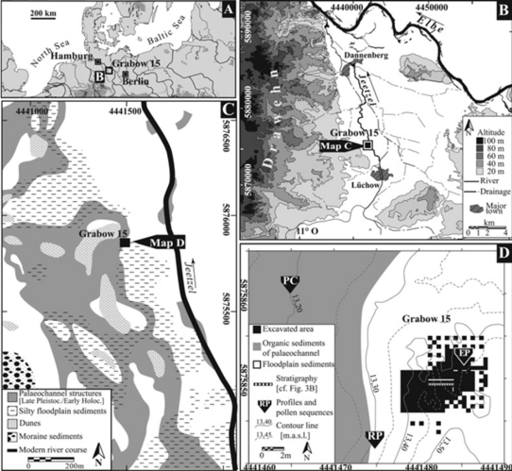The Grabow 15 site is a part of Late Palaeolithic settlement concentrations along the Jeetzel–Elbe corridor. Initial surface reconnaissance in the 1980s by Klaus Breest yielded around 5.000 flint artefacts over a 480 × 130 m area just west of the village of Grabow. Through typological comparison, these were attributed to the Federmessergruppen and later confirmed by dating on charcoal, bone and preserved wood, which place the human activity at Grabow 15 firmly within the early Allerød interstadial (c. 14.200–13.700 years before present). Excavations in 2007–2009, conducted in tightly controlled 50 × 50 cm grid units, revealed rich flint assemblages alongside exceptionally well‑preserved organic materials—amber, charcoal, bone and antler—making Grabow 15 rare among Late Glacial sites in north‑western Europe due to the rich organic preservation. Neighbouring Weitsche 16, only a few hundred metres to the east, produced the extraordinary 14.000‑year‑old amber elk figurine (figure 1)—an icon of northern European Late Palaeolithic art—and further underscores the region’s cultural significance. In addition, the area has yielded many archeological sites from both the Mesolithic (c. 11.600–6.000 years before present) and early Neolithic (c. 6.000–5.000 years before present).

The Grabow 15 site, is located in Northern Germany at the Jeetzel River, which is a tributary to the Elbe River. Although the site is situated on the bank of an abandoned river channel about 13.5 m above sea level, it is still a low-lying site, surrounded by mostly low dunes consisting of late Glacial fluvial sand, and some isolated Saalian moraine hills. The topographical low-lying placement of the site has some consequences too. Based on intercalated layers of palaeosol, it seems that there have been seasonal or other episodic flooding, especially during the early Allerød period. Therefore, the topography and the environment make it unlikely that there would have been a permanent all-year settlement at this site throughout the Allerød period.
Grabow 15 could have functioned as a camp on the margin of a floodplain, repeatedly occupied by small, highly mobile hunter‑gatherer groups of the Federmesser techno‑complex. The large quantities of amber recovered here and at nearby Weitsche—including the famous 14.000‑year‑old elk figurine and a decorated amber pendant (figure 3)—strongly suggest that these communities were engaged in local amber‑working activities.
Excavations at the site uncovered:
We warmly invite scholars, students and the interested public to our Grabow 15 Open Days, which runs throughout the excavation season.
The dates are:
Further details - including the exact location coordinates - will be posted on our social‑media channels.
For enquiries, please contact:
For further information about the area, the archeological history and the findings, see:
Tolksdorf, J.F., Kaiser, K., Bittmann, F., Turner, F., Veil, S. og Eckmeier, E. (2014). Poten- tial of palaeosols, sediments and archaeological features to reconstruct Late Glacial fire re- gimes in northern Central Europe - case study Grabow site and overview. Zeitschrift für Geo morphologie, 58, s. 211-232.
Tolksdorf, J.F., Turner, F., Kaiser, K., Eckmeier, E., Stahlschmidt, M., H., Rupert A., Breest, K. og Veil, S. (2013). Multiproxy Analyses of Stratigraphy and Palaeoenvironment of the Late Palaeolithic Grabow Floodplain Site, Northern Germany. Geoarchaeology, 28, s. 50-65.
Tolksdorf, J.F., Turner, F., Veil, S., Bittmann, F. og Breest, K. (2017). Beaver (Castor fiber) Activity in an Archaeological Context: A Mid-Holocene Beaver Burrow Feature and a Late- Holocene Ecofact at the Late Palaeolithic Grabow Site, Northern Germany. Journal of wet- land archaeology, 17, s. 36-50.
Turner, F., Tolksdorf, J.F., Viehberg, F., Schwalb, A., Kaiser, K., Bittmann, F., von Bramann, U., Pott, R., Staesche, U., Breest, K. og Veil, S. (2013). Lateglacial/early Holocene fluvial reactions of the Jeetzel river (Elbe valley, northern Germany) to abrupt climatic and environmental changes. Quaternary science reviews, 60, s. 91-109.
Veil, S., & Breest, K. (1997). La figuration animale en ambre du gisement Federmesser de Weitsche, Basse-Saxe (Allemagne) et son contexte archéologique: les résultats de la fouille de 1996. Bulletin de la Société préhistorique française, 94(3), 387-392.
Veil, S., Breest, K., Grootes, P., Nadeau, M.-J. og Hüls, M. (2012). A 14 000-year-old amber elk and the origins of northern European art. Antiquity, 86, s. 660-673.